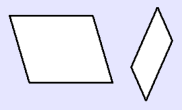These shapes are Rhomboids In geometry, a rhomboid is a parallelogram in which adjacent sides are of unequal lengths and angles are oblique. A shape like a rhomboid with sides of equal length (equilateral) is a rhombus. A shape like a rhomboid with right angled corners is a rectangle. The word Rhomboid which means rhomb-like was commonly used in the 19th century for a parallelogram which was neither a rectangle nor a rhombus. Today it is more often used for a solid figure with six faces in which each face is a parallelogram and opposite faces in pairs lie in parallel planes. Some crystals are formed in 3D rhomboids. It is also sometimes called a rhombic prism. The term shows up frequently in science terminology referring to both its two and three dimensional meaning. Euclid introduces the term in his Elements in Book I, Definition 22, Of quadrilateral figures, a square is that which is both equilateral and right-angled; an oblong that which is right-angled but not equilateral; a rhombus that which is equilateral but not right-angled; and a rhomboid that which has its opposite sides and angles equal to one another but is neither equilateral nor right-angled. And let quadrilaterals other than these be called trapezia. — Translation from the page of D.E.Joyce, Dept. Math. & Comp. Sci., Clark University [1] Euclid never uses the definition of rhomboid again and introduces the word parallelogram in Proposition 31 of Book I; "In parallelogrammic areas the opposite sides and angles are equal to one another, and the diameter bisects the areas." Heath suggests that rhomboid was an older term already in use . See also Links * Eric W. Weisstein, Rhomboid at MathWorld. Retrieved from "http://en.wikipedia.org/"
 |
|
